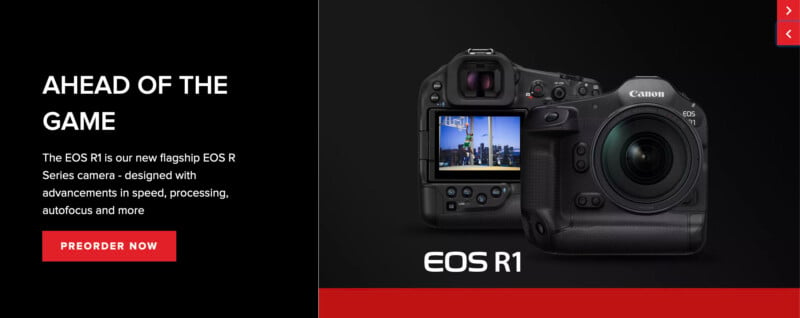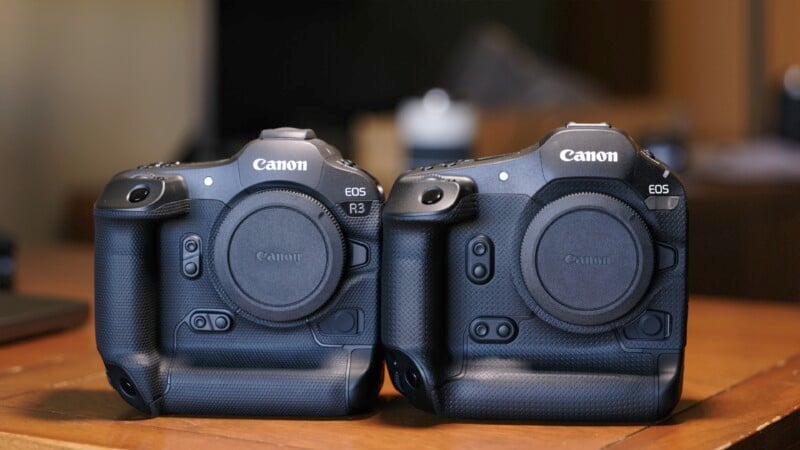Canon Doesn’t Win on Price, Technology, or Public Opinion
![]()
On Tuesday morning, a day before the R1 was announced, I was finalizing our coverage and looking over the materials Canon prepared. “The Canon EOS R1 is Ahead of the Game,” a header in the press release promised. I scratched my head in confusion.
While there are products across Canon’s camera line that I can point to, the most relevant and recent example is the R1. Since it is the flagship — a word Canon selected to describe the new camera, not me — it bears with it the same expectation all flagship cameras do: it must feature the height of technology a company is capable of producing. There are no holds barred on a flagship and it stands as the example of what all the other cameras in a line aspire to be.

“Photographers, if you ‘make it’ as a pro, you’ll one day own a flagship,” is the public perception of these kinds of cameras.
As such, the R1 serves as the perfect exemplification of an issue: Canon isn’t able to win when it comes to price or technology. Worse, its decisions in the mirrorless era have resulted in it losing the crowd on the stage of public opinion.
So while I think Canon’s R5 Mark II is a much more compelling camera than the R1, looking at Canon’s marketing materials and the shooting opportunity that was provided to us, you would see that the R1 was the clear priority. Before we were handed sample units to test out, we were given multiple slides worth of information, told the R1 was carrying on the legacy of the 1-series, and that it was the pinnacle of Canon’s capture technology.
After peeling back the layers and forcing ourselves to isolate what it was that the EOS R1 offered, we were left realizing that there was not as much here as Canon hoped to convince us there was. Holding the R1 in my hands and thinking about what it offered versus how much it was going to cost, “ahead of the game” were four words that felt in direct conflict with reality.
Canon Doesn’t Win on Price
Canon isn’t shy about charging high prices for its products. While it has some more affordable camera bodies, its lens selection is exceptionally weak when it comes to affordability. On the one hand, Canon can be praised for focusing on high-end optics when it launched into mirrorless. Attracting and supporting professional shooters should be the priority. However, on the other hand, now years later, the options are still mostly very expensive.
It is taking some steps to address this by finally allowing Tamron and Sigma to release lenses for the platform, but these will be limited to APS-C lenses, meaning full-frame users still only have one option: Canon and its expensive first-party glass.
Canon told me earlier this year that its choice to bar third-party lenses from its RF mount was a “business strategy.” In short, it could make more money by making its products the only option. Those words kept ringing in my ears and did so again when I saw the price for the R1: $6,300.
That’s more than the Sony a9 III with its global shutter, more than the Nikon Z9 with its higher resolution sensor, and nearly as expensive as the Sony Alpha 1 which melds speed and resolution in a way that justifies its high asking price.
From a “value” perspective, the R1 is the weakest among all of the cameras it competes against. It loses when it comes to resolution against everything except the a9 III and even though it has what we believe is the fastest scanning rolling shutter sensor we’ve yet seen, the a9 III has a global shutter, making it more suited for the same tasks Canon is aiming the R1 toward while costing less.
Could Canon charge this much for a camera? Of course — but only if it has the technology to back it up.
Canon Doesn’t Win on Technology
If you look everywhere on the EOS R1 except at the sensor, it’s jam-packed. It has eye-control autofocus which is incredible, it has a better viewfinder, a robust set of customization options, intelligent autofocus, two on-board chips to improve speed and reliability, a sturdy yet lightweight body, and great battery life. At this point, it looks like the full package.
But then you look at the sensor, and suddenly much of what I just said loses its luster. That’s because no matter how good the rest of the camera is, if it can’t do it at a resolution that matches its contemporaries, it falls short.
Right now, sensor design is one of just a few spots where camera companies can flex technology. Yes, Sony manufactures the sensors for basically everyone except Canon, and in those cases, it’s what is built around those excellent sensors that end up selling a photographer on a particular brand — you have to get that sensor part right first, though. Canon did the opposite and went for the features that would normally excite photographers but neglected to realize it put the cart before the horse.
As we’ve said, the EOS R1 is more like an EOS R3 Mark II than anything else. Canon is charging a price as though it has a camera that’s “ahead of the game” when it in fact only halfway there.
Canon seems confused about what it means to have a flagship camera in 2024. Flagship now means versatile and, unfortunately, the R1 is incredibly niche. It is designed for a very specific, small subsection of professional media photographers. While it has a lot of nice surrounding features, the most important aspect of any camera now is the sensor, and it is there that Canon falls short in some way versus every competitor.
Even stranger, the R1 targets the exact same niche audience that the R3 does, giving Canon two very expensive camera bodies that support the same small subset of users. I should mention, this market isn’t exactly healthy. Photojournalists aren’t paid well and the top-shooters aren’t even buying their own cameras — those are provided by their agency like Reuters, AP, or Gannet. You know, the three major media outlets that already signed deals with Sony.

Canon Doesn’t Win on Public Opinion
The 5D Mark III was such a runaway success that Canon was able to build up an immense amount of goodwill with photographers. The Canon brand became synonymous with performance and professional capability and that trickled down to all of the more affordable models. I remember looking for my first DSLR and feeling like there was no choice except a Canon Rebel. Canon filled out the top-end of DSLRs well with the 1D series too and from the perspective of so many photographers, it was making the best cameras for the most people.
Canon has been riding that wave of goodwill now for more than a decade. I was talking with a friend and professional photographer last week and I asked him to tell me the last time he was excited about a Canon camera after the 5D Mark III. He paused for a while before saying he thought the original R5 was pretty good, which I agreed with (I own one).
But over 22 years, he could only name one camera? I’m sure there are other examples that some photographers loved like the 6D or the 1DX Mark III, but for the most part, I argue Canon has been feeding on the momentum it gathered way back in 2012.
That river has dried up. Canon’s “business strategy” in the mirrorless era have resulted in high prices and worse technology, and photographers have noticed and sentiment has shifted. Whether it is the locked-down RF mount (Canon is the only company that chose to close its mirrorless mount) forcing photographers to buy expensive lenses, the company asking you to buy new cameras to use its newest lenses’ aperture rings, or the company’s weak renewable energy targets, it all adds up.
The result is a brand that feels like it is squeezing its customers for every last cent. It is the most expensive and most limiting camera system and that makes people feel taken advantage of and unappreciated.
Hoping for Change
Canon saw its operating profit decline from January to March of 2024 by 5% compared to the same period last year. This is the first time in four years that its profits declined compared to the same period the previous year. It cited slower-than-expected digital camera sales and “weak” shipments, which makes a lot of sense — what from Canon was worth buying?
When the rest of the camera industry is trending in the opposite direction and some competitors are swimming in record profits, I think that’s the question Canon needs to keep asking itself. The R5 Mark II is very good and I expect it to sell well, but is that enough when Sony and Nikon are producing multiple popular cameras — both of them doing so while charging less? It should be noted that the cameras the R5 II competes well against are at least a couple of years old now, too. What happens when Sony releases an a7R VI or Nikon pulls out a Z8 Mark II? How will the R5 Mark II look then?
Whatever happens, I hope Canon sees that its strategy is not set up for long-term success. Some changes need to be made, and I hope that happens before it has to cut more good people.
Canon says it is “ahead of the game” and if it’s referring to the same game everyone else is playing, I’m not sure it knows how to read the scoreboard.